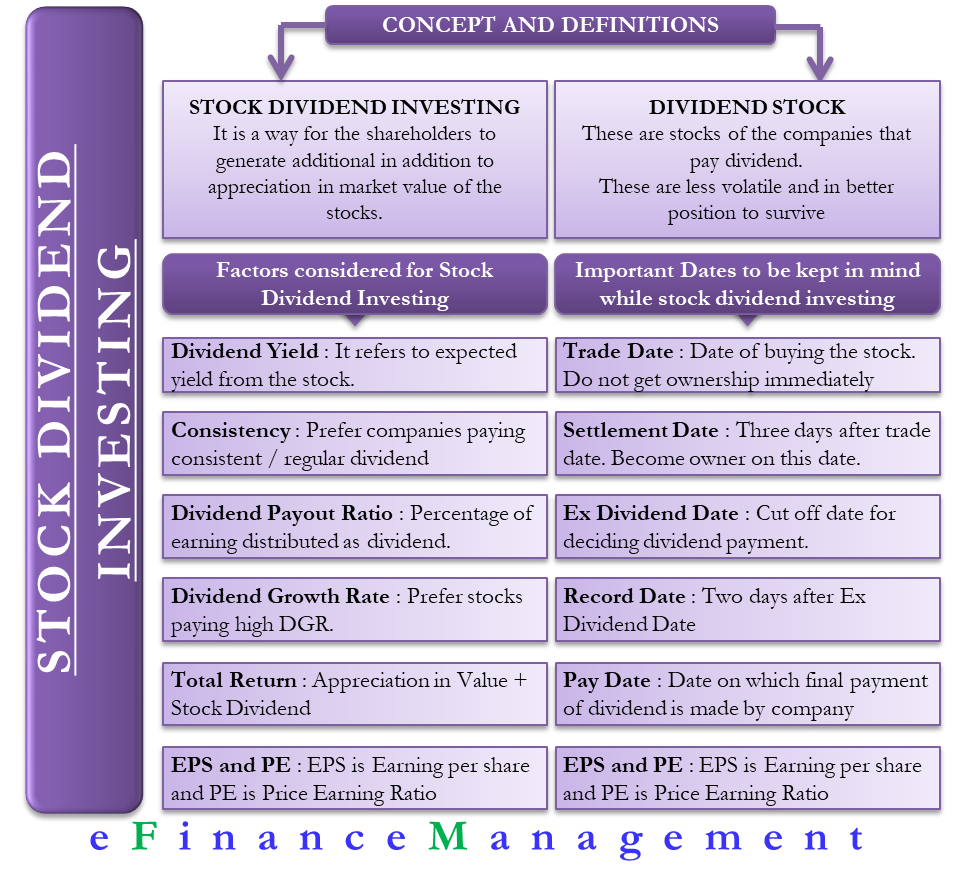Stock dividend investing is a way for shareholders to generate extra income in addition to the appreciation in the market value of their portfolio. Herein, investors buy dividend stocks, which reward them with regular dividends. And, thanks to the power of compounding (or reinvesting), even a small amount of regular dividends can turn into a big amount over a period of time.
What are Dividend Stocks?
Dividend stocks are of companies that pay dividends on a regular basis. Such stocks are usually of well-established companies known for their dividend policy of paying back shareholders. Though such companies aren’t expected to witness a sharp rise in their stock price, their presence in the portfolio could create a good amount of wealth over the long term. Such stocks are less volatile and are in a better position to survive recessions and crashes than other stocks.
Stock Dividend Investing – Strategy
Stock dividend investing is among the most popular investing strategy for traditional, buy-and-hold investors. Investors take into account various factors for such type of investing. These are:
Dividend Yield
It refers to the expected return from the stock in a calendar year. The dividend yield is expressed in the form of a percentage of the stock’s current price. For example, a company’s stock is trading at $100, and it pays a dividend of $5 in the year. In this case, the dividend yield will be 5% ($5/$100). Since the stock price for a company changes on a daily basis, the dividend yield will also change. The dividend yield will move inversely to the stock price. For instance, the yield will drop if the stock price moves up, and vice versa.
Also Read: Dividend Policies
Consistency in Dividend
Investors prefer companies that regularly pay dividends or are consistent with the dividend payment. For example, a company paying (and increasing) dividends for at least the past ten consecutive years is a solid investment option.
Dividend Payout Ratio
A dividend payout ratio is the percentage of earnings that a company distributes as a dividend. For example, a payout ratio of 50% would mean that the firm distributes 50% of the earnings in the form of a dividend. And the rest reinvests in the business for further growth. The larger the payout ratio, the better the company is for the purpose of investing. However, investors mostly avoid firms that pay more than 60% of their profit as dividends. If a company pays more dividends, it will mean it is reinvesting less for future growth.
High Dividend Growth Rate
Under this, investors focus on companies paying lower-than-average dividends but with massive growth potential. So, as the company’s and its profits grow, the dividend amount will increase vastly.
Total Return
This includes both share price appreciation and dividends to show the overall stock performance. For example, if the stock has a dividend yield of 4% and price appreciation is 6%, then the total return is 10%.
EPS and PE
Both these metrics are the most important metric for any investor. EPS is earnings per share, while PE is the price-to-earnings ratio.
Apart from these, investors should focus on other fundamental factors, such as performance history, stable income, cash flow, earnings growth, and stock valuation. Also, investors should evaluate growth prospects by studying the company’s current business environment, future plans, and industry (and economy) market trends.

Important Dates to Know
If you follow stock dividend investing, then there are a few important dates that you must know. These dates will help you to better time your investment to get the next dividend;
Trade Date
It is the date when you buy the stock. You must know that you technically don’t get the ownership of the stock immediately.
Settlement Date
In the stock market, the settlement date is three days after the trade date. This means that if you place an order on Tuesday, the trade will settle on Friday. Also, the settlement date is when you become a shareholder on the company’s record.
Ex-Dividend Date
It is the cut-off date, which means if you buy the shares before the ex-dividend date, you will be eligible for a dividend. However, if you buy shares after this date, you will be eligible for dividends only in the next dividend cycle.
Record Date
This date is usually two days after the ex-dividend date. It ensures that those who bought the shares before the ex-dividend date are shareholders on the company’s books.
Pay Date
It is the date when the company finally pays the dividend to the shareholders.
Tax Implications
Most dividend stocks pay “qualified” dividends, which means they get a special tax treatment. Qualified dividends are taxed at a lower percentage than the ordinary income tax rates. Some dividends are also classified as “ordinary” dividends and thus, are taxed like any other income. Dividend from REITs (Real estate investment trusts) qualifies as “ordinary” dividends.
Final Words
Overall, stock dividend investing could provide a significant source of additional income to the investors. Moreover, this strategy could also yield compelling long-term returns as dividend-paying stocks are often among the consistent performer on Wall Street. If you are investing from the long-term perspective, then it is important that you reinvest your dividend.

